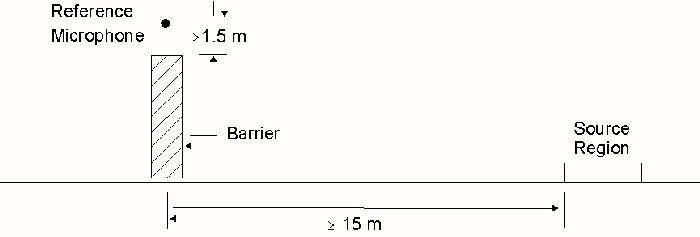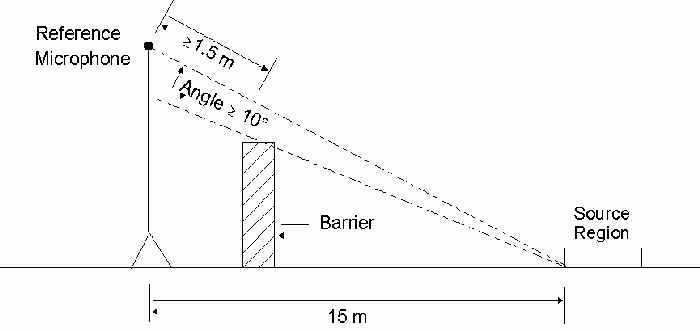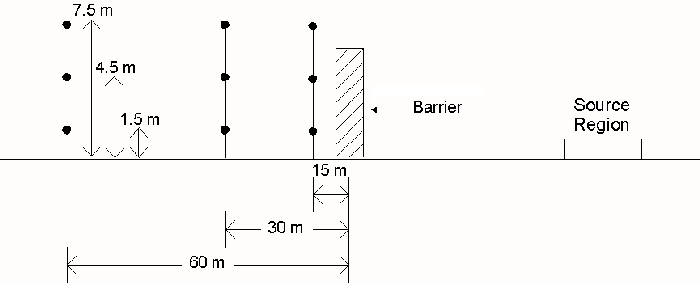Following the construction of a noise barrier system, it may be necessary to evaluate the barrier's acoustical and non-acoustical performance. Such an evaluation may be required for several reasons, including commitments made during the design and/or environmental analysis phases of the project's development or the need to respond to comments related to the barrier's effectiveness made by community residents and motorists.
By comparing the barrier's insertion loss with the design goal insertion loss, the effectiveness of a barrier after construction can be assessed. The insertion loss (IL) is the sound level at a given receiver before the construction of a barrier minus the sound level at the same receiver after the construction of the barrier. IL may also be expressed as the net effect of barrier diffraction, combined with a partial loss of soft-ground attenuation. The partial loss of soft-ground attenuation is due to the barrier forcing the sound to take a higher path relative to the ground plane. To assess the effectiveness of a barrier system, the following basic steps should be assess the effectiveness of a barrier system, the following basic steps should be followed:
Site selection should be guided by the location of noise-sensitive receivers. Land-use maps and field reconnaissance should be used to identify potential noise-sensitive areas. For obvious reasons, schools, hospitals, and churches are especially sensitive to noise impacts. Noise sensitive residential areas should also be included in a noise-impact assessment. When selecting potential representative sites, note that the site should exhibit typical conditions (e.g., ambient, roadway infrastructure, and meteorological) for the surrounding area. It is recommended that good engineering judgment be used to select sites, keeping in mind the objectives of the studyref.19.
The procedures described in this section are in accordance with the American National Standards Institute ANSI S12.8-1998, "Methods for Determining the Insertion Loss of Outdoor Noise Barriers,"ref.9 which provides three methods to determine the field insertion loss of noise barriers: (1) the direct measured method; (2) the indirect measured method; and (3) the indirect predicted method. Readers may also refer to the FHWA's "Measurement of Highway-Related Noise"ref.19 for more detailed discussions on all of the topics contained herein. Also included in this reference are sample field data log sheets.
1. The direct measured method (see Section 15.1.2.1) may be used only if the barrier has not yet been installed or can be removed. Measurements are performed without the barrier to determine "BEFORE" sound levels, and another set of measurements are performed at the same site after construction to determine "AFTER" sound levels.
Note: For a valid determination of barrier insertion loss, BEFORE and AFTER measurements should be made under equivalent source, site, and atmospheric conditions, defined as follows:
| Wind class | Vector component of wind velocity (m/s) |
|---|---|
| Upwind | -1 to -5 |
| Calm | -1 to +1 |
| Downwind | +1 to +5 |
Average temperatures during BEFORE and AFTER measurements may be judged equivalent if they are within 14 degrees Celsius of each other. Also, in certain conditions, dry air produces substantial changes in the atmospheric absorption of sound at high frequencies. Therefore, for a predominantly high-frequency source (most sound energy over 3000 Hz), the absolute humidity for BEFORE and AFTER measurements should be similar, e.g., within 20 percent.
The BEFORE and AFTER acoustical measurements should be made under the same class of cloud cover (See Table 8).
| Class | Description |
|---|---|
| 1 | Heavily overcast |
| 2 | Lightly overcast (either with continuous sun or the sun obscured intermittently by clouds 20 to 80 percent of the time) |
| 3 | Sunny (sun essentially unobscured by clouds 80 percent of the time) |
| 4 | Clear night (less than 50 percent cloud cover) |
| 5 | Overcast night (50 percent or more cloud cover) |
The advantage of using this method is that it ensures identical site geometric characteristics. However, the disadvantages are that equivalent meteorological and traffic conditions may not be reproducible.
2. The indirect measured method (see Section 15.1.2.1) may be used when the barrier has been installed prior to any direct BEFORE measurements and cannot be removed to permit such measurements. In this case, the BEFORE condition is simulated at an equivalent site without the barrier. In this case, BEFORE and AFTER measurements should be performed simultaneously at adjacent locations, if possible. The primary advantage of using this method is that it insures essentially the same meteorological and traffic conditions. The difficulty is that an adjacent equivalent site may not always be available. If an adjacent equivalent site is available, then this method is preferred over the direct measured method.
Note: For a valid determination of barrier insertion loss, BEFORE and AFTER measurements should be made under equivalent source, site, and atmospheric conditions as discussed for the direct measured method.
3. The indirect predicted method may be used if neither direct BEFORE measurements or indirect BEFORE measurements at an equivalent site are possible. In this case, BEFORE levels are predicted using a highway-traffic, noise-prediction model, such as the Federal Highway Administration's Traffic Noise Model (FHWA TNM®). ref.4, ref.5, ref.6 and ref.7 The resulting insertion loss should be referred to as "partially measured." This method is inherently the least accurate of the three methods presented herein (see Section 15.1.2.2).
This section describes briefly the recommended instrumentation, microphone location sampling period, measurement procedures, and data analysis procedures to be used for performing BEFORE and/or AFTER measurements using any of the three methods described above.
-Reference Microphone - The use of a reference microphone is strongly recommended. Use of a reference microphone allows for a calibration of measured levels, which accounts for variations in the characteristics of the noise source, e.g., traffic speeds, volumes, and mixes.
In most cases, a reference microphone is placed between the noise source and other measurement microphones at a height of at least 1.5 m (5 ft) directly above the top edge of the barrier (see Figure 256), and at a distance from the sound source sufficient to minimize near-field effects. Typically, a minimum, standard distance of 15 m (50 ft) from the noise source is used. If the barrier is located less than 15 m from the source, the reference microphone should be placed at a distance of 15 m from the noise source, but at a height such that the line of sight between the microphone and the ground plane beneath the source is at least 10 degrees (see Figure 257). This location should remain the same for all measurements, including measurements at the equivalent site, where the barrier is not present.note 3

Figure 256. Reference microphone - position 1.

Figure 257. Reference microphone - position 2.
-Receiver Positions - In most situations, study objectives will dictate specific microphone locations. As such, this section presents a very generic discussion of microphone locations and assumes no specific study objectives have been identified.
Generally, it is convenient to position microphones at offset distances from the barrier which correspond to incremental doublings of distances (e.g., 15, 30, and 60 m [50, 100, and 200 ft]). Often times measurement sites are characterized by drop-off rates as a function of distance doubling. In terms of microphone height, 1.5 m (5 ft) is the preferred position. If multi-story structures are of interest, including microphones at heights of 4.5 m and 7.5 m (15 ft and 25 ft) may be helpful. Microphone heights should be chosen to encompass all noise-sensitive receivers of interest (see Figure 258).

Figure 258. Receiver positions.
For the purpose of determining barrier insertion loss, it is important to remember that microphone locations relative to the sound source in the BEFORE and AFTER cases must be identical. There may be instances when receivers are placed on the lawns of homes within the community adjacent to a noise barrier.
CAL adjustment = reference level - [(CALINITIAL + CALFINAL) / 2] (dB)
For example:
reference level = 114.0 dB
initial calibration level = 114.1 dB
final calibration level = 114.3 dB
Therefore:
CAL adjustment = 114.0-[(114.1+114.3)/2] = -0.2 dB
3. Adjust measured levels for ambient as follows:
If measured levels do not exceed ambient levels by 4 dB or more, i.e., they are masked, or if the levels at the reference microphone do not exceed those at the receivers, then those data should be omitted from analysis.
If measured levels exceed the ambient levels by between 4 and 10 dB, and if the levels at the reference microphone exceed those at the receivers, then correct the measured levels for ambient as follows (Note: For source levels which exceed ambient levels by greater than 10 dB, the ambient contribution becomes essentially negligible and no correction is necessary):
Ladj=10*log10(100.1Lc-10 0.1La) (dB)
where:
For example:
Lc = 55.0 dB
La = 47.0 dB
Therefore:
Ladj = 10*log10(10(0.1*55.0)-10(0.1*47.0)) = 54.3 dB
4. If appropriate, determine the reflection and/or edge-diffraction bias adjustment.note 4
5. Compute the barrier insertion loss or lower-bound to insertion loss for each source-receiver pair as follows:
For each measurement repetition and each BEFORE/AFTER pair, the insertion loss, or its lower bound, should be determined by subtracting the difference in adjusted reference and receiver levels for the BEFORE case from the difference in adjusted reference and receiver levels for the AFTER case:
ILi = (LAref + Ledge - LArec) - (LBref - Lbrec)(dB)
where:
For example:
LAref = 78.2 dB
Ledge = - 0.5 dB
LArec at receiver 1 = 56.3 dB
LBref = 77.7 dB
LBrec at receiver 1 = 65.0 dB
Therefore:
IL1 = (78.2 - 0.5 - 56.2) - (77.7 - 65.0) = 21.4 - 12.7 = 8.7 dB
Note: The lower bound to barrier insertion loss is the value reported when ambient levels are not directly measured without the sound source in operation, i.e., "assumed" ambient.
As stated earlier, the indirect predicted method requires performing measurements at a site with a barrier to determine AFTER levels, and using a highway-traffic noise-prediction model to predict sound levels without a barrier. This method is inherently the least accurate of the three methods presented. There are many noise prediction methodologies being used by the highway noise community.ref.29, ref.73, ref.74 and ref.75 The current state-of-the-art in highway noise prediction is the FHWA Traffic Noise Model, Version 1.0 (FHWA TNM®). Readers are directed to TNM's Trainer CD-ROM, which provides a detailed tutorial on using TNM, and to three companion reports (TNM's User's Guide, Technical Manual, and data base report). ref.4, ref.5, ref.6 and ref.7 This section describes briefly the procedures associated with the modeling approach.
An evaluation of a barrier system's non-acoustic effectiveness can include objective factors such as structural durability of the barrier and the appearance of the barrier over time. These objective factors generally require that a considerable time period elapse following barrier construction before any evaluation can be made. On the other hand, subjective factors such as community acceptance of the noise barrier system and public perceptions can be evaluated in the time period shortly after the construction of the barrier, as long as the traffic volumes have stabilized at the facility. A wide range of sampling and interviewing techniques are available to obtain input from adjacent landowners and the motoring public.
Opinions expressed by landowners immediately adjacent to a noise barrier typically reflect their perceptions of the noise levels actually heard versus those levels which they had expected to hear. For example, a barrier may be providing a full 10-dB reduction, but if the final with-barrier levels are still near 66 or 67 dBA, it still may be judged as "too loud" or "ineffective" or "no better than before." In addition, perceptions related to the barrier can relate to the intrusiveness of noise and/or the barrier from either an acoustical or non-acoustical standpoint. Landowners living farther from a noise barrier sometimes complain about noise generated by a new installation. In such situations, while noise levels are typically not loud enough to require consideration of noise abatement, a different or new noise exists as the result of a new or upgraded installation. Closer to the installation, residents adjacent to a highway along which a new barrier was constructed on the opposite side may complain about increased noise.
While the potential for opinions and perceptions such as those noted above is inevitable with the construction of any new barrier system, dealing with such factors is primarily a policy-related issue, as compared to a noise barrier design issue. Similar to the specific noise barrier design and analysis policies unique to each state, each state also has a specific and unique policy (whether formalized or not) related to community involvement, public participation, and post-construction evaluation factors. The reader is referred to the specific state noise policies (contained on the companion CD-ROM) for more information.
All states have procedures for evaluating the cost and effectiveness of noise barrier systems. For the most part, a barrier's cost and acoustic effectiveness are factors considered in determining barrier feasibility and reasonableness. The reader is referred to the specific state noise policies (contained on the companion CD-ROM) for details related to the particular items evaluated in such determinations.
Since barrier feasibility and reasonableness evaluations are typically performed during the design phase, they are normally based on modeled noise levels and historical barrier costs. As such, they may not necessarily reflect the final and true cost or effectiveness of a specific as-constructed barrier. If a more refined cost-effectiveness value is desired, a post-construction evaluation may be performed to take into account the following post-construction conditions:
Evaluating costs in this detail may still not provide the true costs related to a specific barrier system, particularly on large projects for which the noise barriers comprise just one relatively small component. Front end loading of specific construction items is often found in construction bid documents for the purpose of establishing contract cash flow. On projects for which noise barrier construction is the major or only item, a determination must be made as to whether or not to include items such as insurance, maintenance, protection of traffic, mobilization, etc. in the barrier cost. More discussion on such cost implications is found in Section 13.